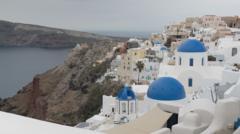In the mesmerizing landscape of Santorini, a popular tourist destination, an urgent examination of the island’s volcanic risks has commenced. Scientists aboard the British research vessel RRS Discovery are conducting unprecedented studies to assess the dangers posed by the underwater volcanoes that lie beneath Santorini's picturesque cliffs, famed white villages, and lucrative tourism.
The volcanic wonder, formed by a catastrophic eruption around 1600 BCE, holds the potential for future explosive activity, underscored by the recent earthquake swarm that caused nearly half of the island's 11,000 residents to seek safety. The seismic activity serves as a stark reminder that the famed beauty of Santorini rests on the unpredictable movements of tectonic plates beneath.
Led by Professor Isobel Yeo from the National Oceanography Centre, the science team emphasizes the need to monitor underwater volcanoes, many of which are overlooked. “Out of sight, out of mind,” Isobel notes, referencing the lack of data on these submerged giants compared to notorious volcanoes like Vesuvius. The research aims to decipher signs of potential eruptions before they transpire, as Santorini's last volcanic event occurred in 1950, with signs of unrest reported as recently as 2012.
The team is studying bubbling hydrothermal vents located 300 meters below the surface, seeking connections between the vents and volcanic activity. As the research progresses, they aim to construct geohazard maps and analyze the intricate relationship between magma movements and the potential for an explosive eruption. This data will prove essential for Greece’s Civil Protection Agency and the island community itself.
For the residents of Santorini, like geologist Professor Paraskevi Nomikou, understanding the volcano’s active state is profoundly personal. Growing up hearing tales of past eruptions, she stresses the importance of this research in helping to educate the local population on safety measures and evacuation protocols in the case of future eruptions.
However, the recent earthquakes exacerbate concerns for local businesses reliant on tourism. Photographers and wedding planners, such as Eva Rendl, have felt the impact as potential clients cancel bookings out of fear. Tourists like British-Canadian Janet have expressed a desire for more scientific information to reassure them about visiting during uncertain times. Yet others, like newlyweds Tom and Kristina, remain undeterred, even seeking the thrill of a volcanic backdrop for their wedding photos.
As scientists race against time to provide crucial insights, the age-old battle between nature’s awe-inspiring beauty and its hidden dangers continues. This mission is not just an academic pursuit; it’s a quest for safety and reassurance for those who call Santorini home, and for the countless visitors drawn to its breathtaking vistas.
The volcanic wonder, formed by a catastrophic eruption around 1600 BCE, holds the potential for future explosive activity, underscored by the recent earthquake swarm that caused nearly half of the island's 11,000 residents to seek safety. The seismic activity serves as a stark reminder that the famed beauty of Santorini rests on the unpredictable movements of tectonic plates beneath.
Led by Professor Isobel Yeo from the National Oceanography Centre, the science team emphasizes the need to monitor underwater volcanoes, many of which are overlooked. “Out of sight, out of mind,” Isobel notes, referencing the lack of data on these submerged giants compared to notorious volcanoes like Vesuvius. The research aims to decipher signs of potential eruptions before they transpire, as Santorini's last volcanic event occurred in 1950, with signs of unrest reported as recently as 2012.
The team is studying bubbling hydrothermal vents located 300 meters below the surface, seeking connections between the vents and volcanic activity. As the research progresses, they aim to construct geohazard maps and analyze the intricate relationship between magma movements and the potential for an explosive eruption. This data will prove essential for Greece’s Civil Protection Agency and the island community itself.
For the residents of Santorini, like geologist Professor Paraskevi Nomikou, understanding the volcano’s active state is profoundly personal. Growing up hearing tales of past eruptions, she stresses the importance of this research in helping to educate the local population on safety measures and evacuation protocols in the case of future eruptions.
However, the recent earthquakes exacerbate concerns for local businesses reliant on tourism. Photographers and wedding planners, such as Eva Rendl, have felt the impact as potential clients cancel bookings out of fear. Tourists like British-Canadian Janet have expressed a desire for more scientific information to reassure them about visiting during uncertain times. Yet others, like newlyweds Tom and Kristina, remain undeterred, even seeking the thrill of a volcanic backdrop for their wedding photos.
As scientists race against time to provide crucial insights, the age-old battle between nature’s awe-inspiring beauty and its hidden dangers continues. This mission is not just an academic pursuit; it’s a quest for safety and reassurance for those who call Santorini home, and for the countless visitors drawn to its breathtaking vistas.



















